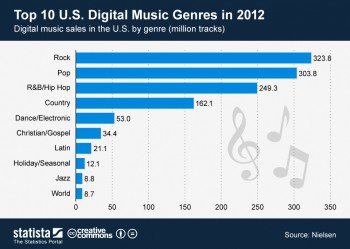Whitney Houston, EDM, Vinyl: Inside The Music Stats of 2012
Last week the Nielsen Company and Billboard released their annual year-end report on music sales. And for industry watchers, it was seven pages of pure statistical deliciousness.
The boldface highlights have already been trumpeted. As measured by Nielsen SoundScan, overall music sales reached an another all-time high, with unit sales increasing 3.1% over last year. Overall album sales dipped 4.4%, from 331 million in 2011 to 316 million, but that doesn’t seem so surprising—or drastic—given that we’ve been lamenting the death of the album for years.
More albums were sold by digital music stores than by any other type of retailer, including mass merchants like Best Buy, for the first time in history. Yet vinyl continued its improbable rise (which I wrote about more extensively last year) as LP sales soared 17.7% to 4.6 million, setting a new SoundScan Era record for the fifth consecutive year.
On the artist front, Adele sold 5.1 million albums in 2012 after moving 5.8 million in 2011, making 21 the first album in SoundScan’s history to be the top seller two years in a row. Taylor Swift moved 3.1 million copies in the last 10 weeks of 2012, basically ensuring she’ll be among music’s top earners in 2013. Carly Rae Jepsen’s “Call Me Maybe” and Gotye and Kimbra’s “Somebody That I Used To Know” sold a lot of copies—6.5 million and 6.8 million, respectively—but we already knew that.
Some of the most fascinating stories, however, are located beyond the first page of Nielsen’s report. Take, for instance, the sales figures for individual genres. Of the five most popular genres in terms of total tracks sold, the fastest-growing is Dance/Electronic, with sales surging 35.6%.
That’s not much of a surprise, as the story of EDM’s rise has been told by many, including FORBES. But what might shock some people is that, despite the fact that a sizeable portion of EDM tracks are distributed for free online, the Dance/Electronic genre’s sales of 53 million are already about one-third the size of the market for Country. That should serve as proof that EDM isn’t going away anytime soon.
Of the remaining three biggest genres, Pop sales are essentially flat at 304 million, Rock grew 11% to 324 million tracks and R&B/Hip-Hop dipped 5% to 249 million. Rock’s roll was boosted in part by Mumford & Sons’ Babel, which moved 1.46 million copies, making it the No. 4 album of the year in terms of overall sales. The group earned the No. 6 spot last year for Sigh No More.
Mumford & Sons and Adele weren’t the only artists to post two huge years in a row. Katy Perry earned the most airplay for the second consecutive year, thanks to her Teenage Dream re-release. She and Michael Jackson remain the only two artists with five No. 1 hits from the same album.
Another interesting statistic: out of all the decades from the 1940s onward, the era that got the biggest boost this year in terms of digital album sales was the 1980s. That decade’s music got a bump of 32.7%—more, even, than the music of the 2010s.
Why? In addition to continued demand for the music of the aforementioned King of Pop and other iconic artists who were particularly prolific in the 1980s, the decade’s music got a massive boost from Whitney Houston. The late diva sold 1.8 million albums last year, No. 7 among all artists.
Finally, the last page of Nielsen’s report contains one of the most crucial clues to the future of music: streaming stats. “Call Me Maybe” was the year’s most-streamed song with 119 million audio and video plays–20 times the number of singles the song sold.
As more and more people move their music consumption to services like Pandora and Spotify, the mp3 might just be going the way of the CD. And that could throw a major wrinkle into next year’s report. [Forbes]

